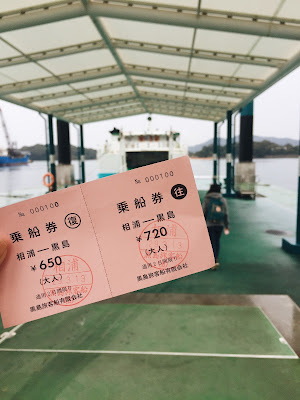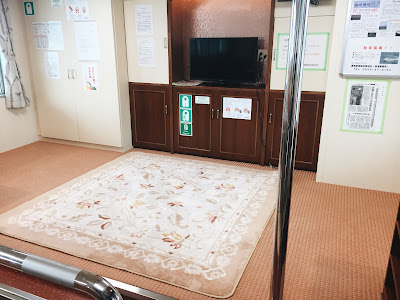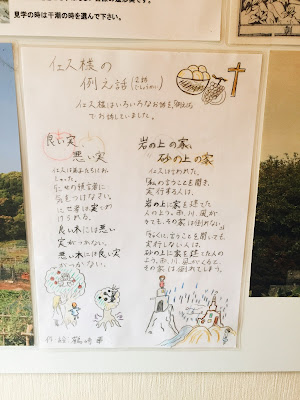Since my sister is here, I wanted to bring her somewhere special. A little googling led me to Kuroshima island, which is famous for being one of the places where Christians hid during the persecution in Japan (mainly in the Tokugawa era). Another place would be the Goto islands, which is mentioned in Silence, but this seemed to be easier to get to. Because I didn’t know how to get around the island, I decided to book a personalised tour from a minshuku called Tsurusaki (site is only in Japanese, as is the tour). We just asked for the tour of the island, but you can add options like making tofu or the local speciality buns. You can also get more information from the Kuroshima Tourism site – this has multiple language options.
To get to Kuroshima, you need to take a train to Ainoura station and a ferry from the terminal there. There are only three crossings made a day, so you absolutely do not want to miss your ride.
It costs 1,370 yen for a round-trip journey. The boat also has a heated rug, which is incredibly comfortable to sit on (or sleep on, if you’re very tired). Boarding starts 30 min before the ship sets sail.
We were greeted by the guide and after a short stop at the minshiku, we started on our tour! I took lots of notes, so I’m breaking this into two blogposts.
Kuroshima Catholic Church
Kuroshima Catholic Church is 114 years old. Since the island is 90% Catholic, you can basically see everyone if you stay long enough for mass (in the evening and in the morning). The Church was built in two years with help from the parishioners. Those who could give money, gave, while those who couldn’t give money donated their time. According to our guide, the cost of the Church would have been much higher if there weren’t volunteer builders.
If you look closely at the windows, you’ll notice that they look boarded up. The stain glass is visible from the inside, but these “boards” (it’s more like an extra frame?) were added later because Kuroshima experiences some pretty intense typhoons and the branches from the trees next to the Church (they are just visible on the right side of this photo) would break off and hit the windows.
| Back of the Church |
The cost, if you’re wondering, was 15,000 yen, which translates to 300,000,000 yen of today’s money (1 yen back then is worth 20,000 yen today).
| Front of the Church |
Some of the bricks were baked on the island! The guide pointed out the field that they were baked in, which is at the back of the Church:
But, because the volunteers weren’t professional builders, the bricks were burnt. If they were to use them all in the same place, one section of the Church would have looked weird so they spread the burnt bricks all over the Church.
| Spot the burnt bricks! |
These stones are also from the time it was built and they are from the island! The stones are called 御影石 (mikageishi) and when they are polished, they are really beautiful! The alter inside (no photos were allowed, sadly) was of polished stone and I really couldn’t believe that these were the same stones!
These “windows” were bricked in because the Church didn’t have enough money and couldn’t afford to put in the stained glass that they originally planned.
And this is the rope that rings the bell! The sisters are in charge of ringing it every day.
You can’t see the inside, but they actually etched patterns on the wood, to mimic the look of tree rings. This leads to some rather odd patterns (for example, some of the “rings” are only possible if the tree is sliced horizontally, which would make it a circle), but the Father that built this Church wanted to make it as nice as possible. The designs were made by adding some kind of lacquer and then running combs through it. Fun fact: the main doors have the more detailed attention but the side doors and ceilings have simpler designs.
Oh, and the basin that holds the holy water for parishioners to anoint themselves are made with large shells from the island!
The Father that I mentioned is Father Marman, who was a French priest (if I remember correctly).
Last few notes that I have:
– The Church still sits men and women separately, which is why there are two areas for confessions (and the confession area isn’t a confession box, which means that you make your confession in front of everyone in the Church). The women also wear veils over their head.
– Just in front of the Church is a building where funeral services are held. They used to be held at the homes, but the homes are rather small so this was built to accommodate everyone.
– The tiles in the front are made in Arita and they are a specially commissioned design with crosses within crosses.
Local Graveyard
I would just like to say that I did have permission to take this photo:
This is a graveyard for the Catholics on Kuroshima. The black stones are imported stones, while the grey stones are the local stones that I mentioned earlier. And the taller graves are the more recent ones, while the smaller graves are older.
According to our guide, the flowers at the graves are fake because while the Buddhists are concentrated in one area (and can tend to the graves every day), the Catholics of Kuroshima are spread out and can’t visit every day. Hence, they use fake flowers that can last. They also add stones to the vases if there aren’t enough flowers so that the crows can’t steal them.
Lunch
Our third stop was lunch at Tsurusaki. This lunch only cost us 1,200 yen per person, which I find incredibly cheap! I don’t have the number for the tour at hand, but I’ll have it to you by the next post. And now, pictures of the food!
The sashimi was incredibly fresh and delicious (locally caught food!)
Homemade tofu which my sister and I both loved. It’s sweet and slightly salty at the same time and I wish that we did take the tofu making course because that would mean we get to bring some home.
The fish is lightly steamed and that’s all it needs. According to our guide, the fish is freshly caught (they have a deal with one of the fishermen because there aren’t any supermarkets on the island which means they need to be self-sufficient.)
And these are incredibly juicy oysters. I think I forgot to take a picture of the miso soup, but it was sweeter than normal, possibly from the fish that was inside. It was, altogether, an extremely satisfying lunch.
We also saw this at the doorway! It’s the parable of the good and bad seed, as well as the parable of the man who built his house on the rock. It’s drawn by our guide’s grandchild!
This is all for the morning, and I’ll continue with the afternoon portion of the tour next time.



